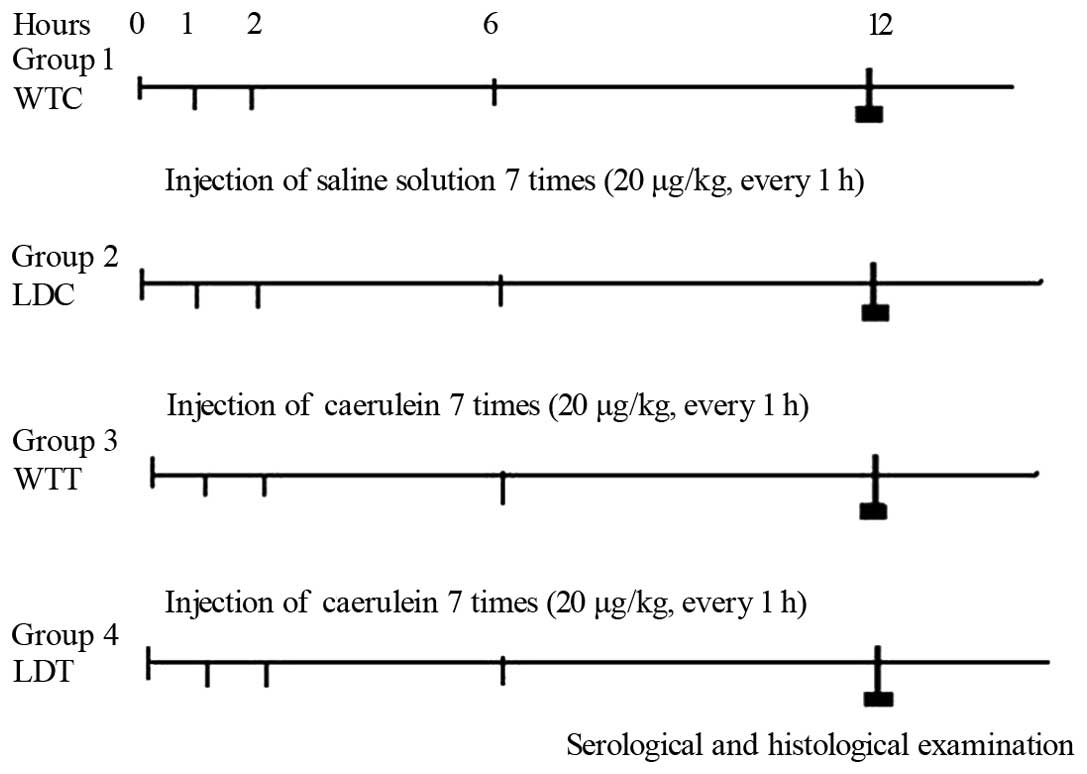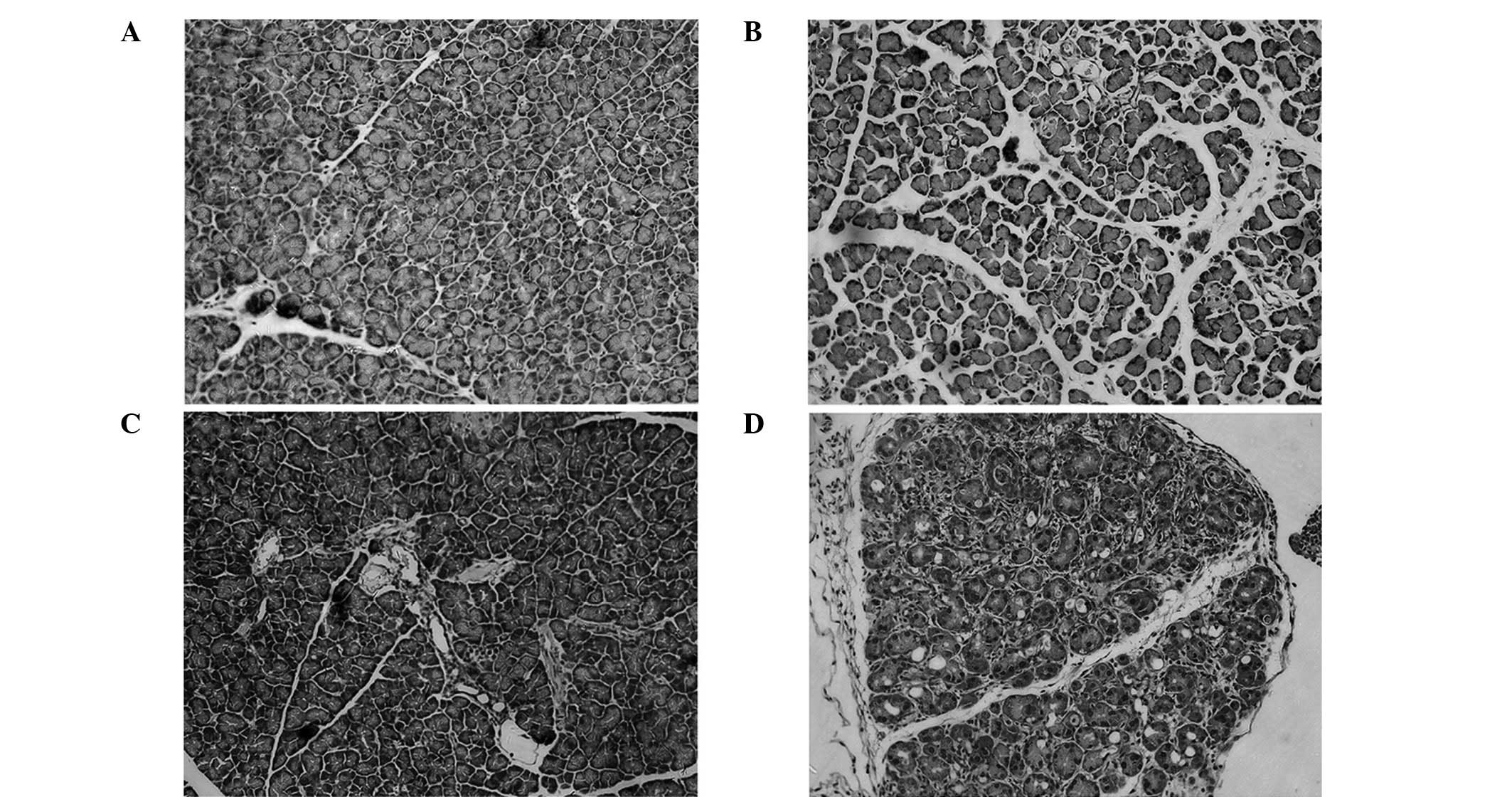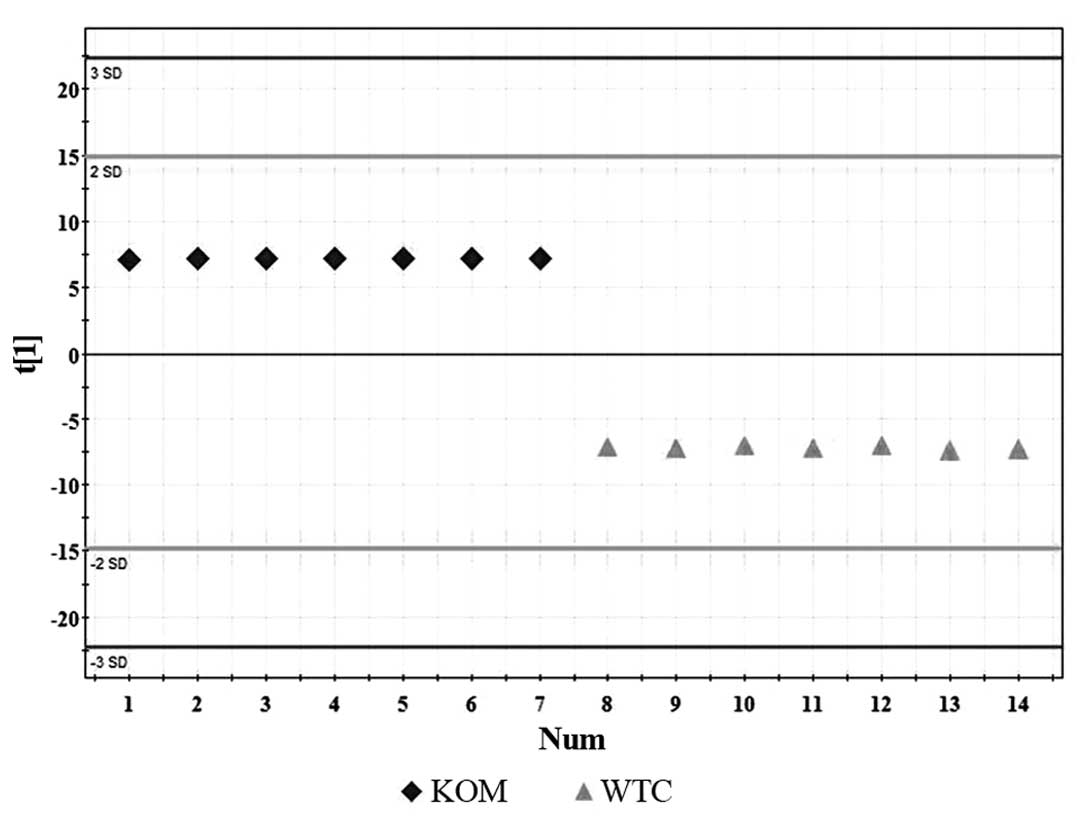A serum metabolomic investigation on lipoprotein lipase‑deficient mice with hyperlipidemic pancreatitis using gas chromatography/mass spectrometry
- Authors:
- Published online on: March 12, 2013 https://doi.org/10.3892/br.2013.78
- Pages: 469-473
Abstract
Introduction
Hypertriglyceridemia (HTG) is associated with acute pancreatitis in 12–38% of reported cases. The relationship between these diseases and the role of hypertriglyceridemia in acute pancreatitis pathogenesis remains to be elucidated (1). Although the pathogenesis of acute pancreatitis depends on a number of factors, its recurrent form is the most common complication of HTG and is often observed in type I hyperlipoproteinemic patients with various lipoprotein lipase (LPL) or apolipoprotein CII gene mutations (2). LPL-deficient HTG heterozygous mice were rescued by somatic gene transfer of a mutant LPL gene. The surviving animals exhibited LPL deficiency with high plasma triglyceride (TG) levels during adulthood (3). Thus, this study aimed to assess the susceptibility of LPL-deficient heterozygous mice with HTG to pancreatitis. Furthermore, gas chromatography/mass spectrometry (GC/MS) was utilized to compare serum metabolite levels between normal controls and hyperlipidemic acute pancreatitis (HLP) subjects.
The recent revival of systems biology that integrates the pertinent components, such as genes, proteins and metabolites, into a holistic biological network provides a comprehensive understanding of system behavior (4,5). Metabolomic profiling is a practical approach used to determine system response to perturbations by measuring variations in small molecule/endpoint metabolic products resulting from systemic biochemical regulation (6). In this study, we aimed to demonstrate the use of GC/MS for HLP serum metabolic analysis, and provide potential metabolic biomarkers to distinguish HLP subjects from normal subjects.
Materials and methods
Animals
LPL-deficient mice were rescued from neonatal death by intramuscular injection of an adenoviral vector coding a naturally occurring human LPL beneficial mutant, Ad-LPLS447X, as previously described (3). Animals injected with saline were used as the control. Genotyping was performed by polymerase chain reaction. LPL-deficient heterozygous mice were hybridized by female wild-type and LPL-deficient mice. Female wild-type and LPL-deficient mice with a C57B6 background at 8 weeks weighing 13–16 g were used for the experiments. The animals were fed a normal chow diet and had free access to water. The ‘Principles of Laboratory Animal Care’ (NIH publication no. 85-23, revised 1996) was followed and the experimental protocol was approved by the Animal Care Committee, Peking University Health Science Center.
Experimental group
The experimental protocol is shown in Fig. 1. Four groups were prepared: group 1 [WTC, wild-type control: 0.9% sodium chloride was intraperitoneally (i.p.) injected 7 times over 1 day], group 2 (LDC, LPL-deficient heterozygous control), group 3 [WTT, acute pancreatitis model; caerulein was i.p. injected 7 times over 1 day, Sigma Aldrich Chemie GmbH (Steinheim, Germany) dosage, 20 μg/kg b.w. every hour] and group 4 (LDT HLP model). Blood samples were collected 12 h after injection to measure amylase, triacylglycerol (TG) and conduct GC/MS analysis. Mice were then sacrificed and pancreatic tissues were fixed in buffered formalin and embedded in paraffin.
Biochemical measurement and histopathology
Serum was analyzed for amylase and TG concentrations using commercial kits (Biosino Bio-Technology and Science, Beijing, China). Histological samples were fixed in 10% buffered formalin, embedded in paraffin, sectioned and stained with hematoxylin and eosin stain (H&E).
GC/MS sample preparation, derivatization and spectral acquisition
Serum samples collected from fasting subjects were kept frozen at −80°C until use, at which point the ice samples were thawed. Each 200-μl aliquot of the serum samples was added to a 1.5 ml tube followed by the addition of 400 μl of acetone for protein precipitation. The mixture was vortexed for 30 sec and centrifuged at 10,000 × g for 10 min. A 400-μl supernatant was transferred to a 500 μl of glass tube and dried under vacuum. The dried analytes were dissolved in 80 μl of methoxylamine hydrochloride (15 mg/ml, dissolved in pyridine) for 90 min at 30°C and then silylated with 80 μl N,O-bis(trimethylsilyl)-trifluoroacetamide (BSTFA) and trimethylchlorosilane (at a ratio of 99:1) (Supelco, Bellefonte, PA, USA) for 2 h at 70°C. Each 70-μl aliquot of hexane was added to the derivatization flasks. After the sample was stirred for 1 min and kept at room temperature for 1 h, 1-μl aliquot of the solution was injected into a PerkinElmer GC coupled with a TurboMass-Autosystem XL mass spectrometer (PerkinElmer, Inc., St. Waltham, MA, USA) in the splitless mode. A DB-5MS capillary column coated with 5% diphenyl cross-linked 95% dimethylpolysiloxane (30 m × 250 μm i.d., 0.25-μm film thickness; Agilent J&W Scientific, Folsom, CA, USA) was used for separation. The injection and interface temperatures were set to 260°C and the ion source temperature was adjusted to 200°C. Initial GC oven temperature was set at 80°C for 2 min following injection and then raised up to 285°C with 5°C/min and maintained at 285°C for 7 min. Helium at a flow rate of 1 ml/min was used as the carrier gas. Measurements were made with electron impact ionization (70 eV) in the full scan mode (m/z 30–550) (7).
Data analysis
Biochemical measurement results were expressed as the mean ± standard deviation (SD). Statistical evaluation was performed with SPSS 11.0 and differences between the 2 groups were tested by independent t-tests. P<0.05 was considered statistically significant.
GC/MS data files were converted into NetCDF format via DataBridge (PerkinElmer, Inc.) and pretreatment was conducted as previously described (8). The mean-centered and autoscaled data were then introduced into SIMCA-P 11.5 Software (Umetrics, Umeå, Sweden) for multivariate statistical analysis. Principal component analysis (PCA) was used to obtain an overview of variations among the different groups. Orthogonal-projections to latent structures-discriminant analysis (OPLS-DA), a supervised pattern recognition approach, was utilized to construct a predictive model to identify the differential metabolites involved in causing disease. To avoid the overfitting of the models, the OPLS-DA model was carefully validated by the following three steps: i) an iterative 7-round cross-validation with one seventh of the samples being excluded from the model in each round (9); ii) 1,000 random permutations test (10); iii) blind prediction test in which the data set was randomly divided into the training set (70%) and test set (30%) and the model built on the training set was applied to construct the classification model to predict the class membership of the test set (11).
Results
Histopathologic observation
No discernable pathological alteration in either wild-type or LPL-deficient heterozygous mice injected relative to the saline-injected control was observed. However, mice injected with caerulein exhibited pancreatic injury including edema, neutrophil infiltration, hemorrhage and parenchymal necrosis. In LPL-deficient heterozygous mice injected with caerulein, pancreatic injury was more severe compared to other mice (Fig. 2).
Measurement of serum amylase and plasma triglyceride (TG) levels
Serum amylase levels increased after caerulein injection in both wild-type and LPL-deficient mice, but were significantly higher in LPL-deficient heterozygous mice 12 h after injection. The difference between wild-type control and LPL-deficient control mice was not significant. Moreover, the plasma TG levels in LPL-deficient mice were significantly higher than the control animals (Table I, P<0.05).
GC/MS spectroscopic data analysis
Compound identification was carried out either by comparing mass spectra and retention time with values obtained from commercially available reference compounds or based on commercial libraries of NIST, NBS and Wiley. We were able to identify metabolites, primarily organic acids, amino acids and free fatty acids (FFA). The OPLS-DA model calculated from GC/MS data of HLP vs. wild-type subjects was employed. There were more differentially expressed metabolites identified in HLP compared to the healthy group (Table II and Fig. 3), including compounds such as valine, leucine, glutamine, proline, citrate, malic acid, tetradecanoic acid (14:0) and oleic acid (18:1).
Table IIStatistical analysis of differentially expressed endogenous metabolites correlated with HLP and wild-type mice. |
Discussion
HLP typically presents as an episode of acute pancreatitis or recurrent acute pancreatitis (1) and has a high morbidity rate. It is important to determine the pathogenetic factors involved as the disease is treatable and recurrences can be prevented (12). The mechanisms by which hyperlipidemia induces acute severe pancreatitis have yet to be elucidated.
LPL-deficient heterozygous mice developed pancreatitis subequent to caerulein stimulation. It appears that pancreatic cells are more susceptible to damage by an additional stimulus or injury in the presence of high TG plasma levels surrounding pancreatic cells (13). Once cells are damaged, high concentrations of pancreatic lipase, exceeding normal blood plasma levels, may reach the interstitium.
Although various animal models for chronic, acute or severe pancreatitis have previously been established and investigated (14–16), no appropriate HLP model has been developed. In this study, by using the combination of LPL-deficient heterozygous mice and injection with caerulein, we established animal models for HLP and conducted further studies using these models.
Since HLP is a metabolic disorder that disturbs the metabolism of carbohydrates, lipids and amino acids, the pathological process likely involves an altered expression of downstream low molecular weight metabolites such as glucose. This study was designed to visualize the alteration of global serum metabolites associated with HLP pathophysiology. Compared to healthy controls, the HLP subjects exhibited altered serum metabolites (Table II) including significantly increased valine, leucine, proline, tetradecanoic acid (14:0) and oleic acid (18:1), as well as decreased citrate, malic acid and glutamine levels. Several pathways involving the tricarboxylic acid (TCA) cycle (citrate and malic acid) and glutamate and glutamine biosynthesis were affected.
Citrate, malic acid and glutamine are crucial components of the TCA cycle, which is the main pathway of glucose degradation and primary energy supplier for most organisms. These compounds were significantly decreased in the HLP subjects than in the healthy control animals, suggesting that HLP may inhibit the activity of these compounds, ultimately repressing energy metabolism. As the metabolic enzymes of the TCA cycle are located mainly in the mitochondria, TCA cycle disorder results in disrupted mitochondrial function.
Compared to healthy controls, the HLP subjects exhibited altered serum metabolites (Table II) including significantly increased oleic acid (18:1) and tetradecanoic acid (14:0). This suggests a hypercatabolic state in HLP subjects, which is consistent with previously reported results (17–19). A well-accepted mechanism initially proposed by Havel (20) states that TG hydrolysis in and around the pancreas by pancreatic lipase seeping out of the acinar cells, leading to the accumulation of FFA in high concentrations. FFA may disturb microcirculation in the pancreas via detrimental effects on the vessel endothelium (21,22). A metabolic factor may play a key role in HLP pathogenesis.
In conclusion, LPL-deficient mice with high HTG have enhanced susceptibility to pancreatitis. Serum metabolite profiling using GC/MS in conjunction with modern multi variate statistical techniques permits non-invasive, simultaneous monitoring of numerous metabolic pathways. Significantly altered serum metabolites were detected in HLP subjects and these changes impact some biochemical pathways.
Abbreviations:
|
FFA |
free fatty acid |
|
HTG |
hypertriglyceridemia |
|
GC/MS |
gas chromatography/mass spectrometry |
|
PCA |
principal component analysis |
|
OPLS-DA |
orthogonal projections to latent structures discriminant analysis |
|
TG |
triglyceride |
|
HLP |
hyperlipidemic acute pancreatitis |
|
H&E |
hematoxylin and eosin stain |
|
LPL |
lipoprotein lipase |
Acknowledgements
This study was supported by the National Natural Science Foundation of China (grant no. 30971359). We would like to thank the technical support of Li Cheng, Zhenjun Gao and Kai Wu at the Department of Gastroenterology of Shanghai Jiaotong University Affiliated First People’s Hospital.
References
|
Yadav D and Pitchumoni CS: Issues in hyperlipidemic pancreatitis. J Clin Gastroenterol. 36:54–62. 2003. View Article : Google Scholar : PubMed/NCBI | |
|
Toskes PP: Hyperlipidemic pancreatitis. Gastroenterol Clin North Am. 19:783–791. 1990.PubMed/NCBI | |
|
Ross CJ, Liu G, Kuivenhoven JA, et al: Complete rescue of lipoprotein lipase-deficient mice by somatic gene transfer of the naturally occurring LPLS447X beneficial mutation. Arterioscler Thromb Vasc Biol. 25:2143–2150. 2005. View Article : Google Scholar : PubMed/NCBI | |
|
Hood L and Perlmutter RM: The impact of systems approaches on biological problems in drug discovery. Nat Biotechnol. 22:1215–1217. 2004. View Article : Google Scholar : PubMed/NCBI | |
|
Hwang D, Rust AG, Ramsey S, et al: A data integration methodology for systems biology. Proc Natl Acad Sci USA. 102:17296–17301. 2005. View Article : Google Scholar : PubMed/NCBI | |
|
Nicholson JK, Holmes E and Wilson ID: Gut microorganisms, mammalian metabolism and personalized health care. Nat Rev Microbiol. 3:431–438. 2005. View Article : Google Scholar : PubMed/NCBI | |
|
Bao Y, Zhao T, Wang X, et al: Metabonomic variations in the drug-treated type 2 diabetes mellitus patients and healthy volunteers. J Proteome Res. 8:1623–1630. 2009. View Article : Google Scholar : PubMed/NCBI | |
|
Wang X, Su M, Qiu Y, et al: Metabolic regulatory network alterations in response to acute cold stress and ginsenoside intervention. J Proteome Res. 6:3449–3455. 2007. View Article : Google Scholar : PubMed/NCBI | |
|
Ni Y, Su M, Lin J, et al: Metabolic profiling reveals disorder of amino acid metabolism in four brain regions from a rat model of chronic unpredictable mild stress. FEBS Lett. 582:2627–2636. 2008. View Article : Google Scholar : PubMed/NCBI | |
|
Westerhuis JA, Hoefsloot HCJ, Smit S, et al: Assessment of PLSDA cross validation. Metabolomics. 4:81–89. 2008. View Article : Google Scholar | |
|
Jellum E, Bjornson I, Nesbakken R, et al: Classification of human cancer cells by means of capillary gas chromatography and pattern recognition analysis. J Chromatogr. 217:231–237. 1981. View Article : Google Scholar : PubMed/NCBI | |
|
Karne S and Gorelick FS: Etiopathogenesis of acute pancreatitis. Surg Clin North Am. 79:699–710. 1999. View Article : Google Scholar | |
|
Wang Y, Sternfeld L, Yang F, et al: Enhanced susceptibility to pancreatitis in severe hypertriglyceridaemic lipoprotein lipase-deficient mice and agonist-like function of pancreatic lipase in pancreatic cells. Gut. 58:422–430. 2009. View Article : Google Scholar | |
|
Frossard JL and Pastor CM: Experimental acute pancreatitis: new insights into the pathophysiology. Front Biosci. 7:d275–d287. 2002. View Article : Google Scholar : PubMed/NCBI | |
|
Esposito I, Friess H and Buchler MW: Molecular mechanisms in chronic pancreatitis. Zentralbl Chir. 126:867–872. 2001. View Article : Google Scholar : PubMed/NCBI | |
|
Gaeta L, Dionigi G and Dionigi R: Experimental models of acute pancreatitis. Critical review. Chir Ital. 52:469–497. 2000.(In Italian). | |
|
Chen M, Zhao L and Jia W: Metabonomic study on the biochemical profiles of a hydrocortisone-induced animal mode. J Proteome Res. 4:2391–2396. 2005. View Article : Google Scholar : PubMed/NCBI | |
|
Chen M, Su M, Zhao L, et al: Metabonomic study of aristolochic acid-induced nephrotoxicity in rats. J Proteome Res. 5:995–1002. 2006. View Article : Google Scholar : PubMed/NCBI | |
|
Wang Y, Holmes E, Nicholson JK, et al: Metabonomic investigations in mice infected with Schistosoma mansoni: an approach for biomarker identification. Proc Natl Acad Sci USA. 101:12676–12681. 2004. View Article : Google Scholar : PubMed/NCBI | |
|
Havel RJ: Pathogenesis, differentiation and management of hypertriglyceridemia. Adv Intern Med. 15:117–154. 1969.PubMed/NCBI | |
|
Hofbauer B, Saluja AK, Lerch MM, et al: Intra-acinar cell activation of trypsinogen during caerulein-induced pancreatitis in rats. Am J Physiol. 275:G352–G362. 1998.PubMed/NCBI | |
|
Mayer J, Rau B, Schoenberg MH, et al: Mechanism and role of trypsinogen activation in acute pancreatitis. Hepatogastroenterology. 46:2757–2763. 1999.PubMed/NCBI |












